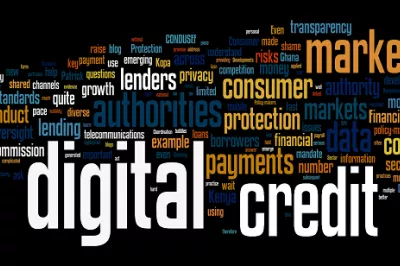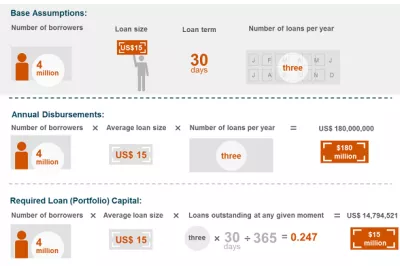An Introductory Course to Digital Credit
CGAP has been tracking the proliferation of digital credit services over the past two years. It is obvious that there is huge innovation and creativity in this area, but (as should be expected) there are many cases where basic fundamental miscalculations have occurred.
Among a number of lessons learned, we have spoken with providers about the following six early errors made by digital credit pilots and deployments:
- Offering credit without a strong remote identification system. When you can’t verify customer identity, offering remote services is difficult, especially at scale.
- Poor targeting, where credit offerings attracted a high-risk applicant pool.
- Cumbersome loan application processes that meant few people came forward to apply.
- Credit scoring models that were too conservative and did not allow credit to be extended to more than a small fraction of applicants.
- Poor product design, such as a transfer fee for moving money to/from a mobile money account that quickly made the product unviable.
- An excessive focus on credit scoring but the absence of a sound collections strategy.
These are some of the early learnings CGAP aims to help address with An Introduction to Digital Credit, a self-directed, one-day course for practitioners, regulators and others with an interest in digital credit. The course material outlines basic concepts and provides an overview of new, emerging models. It provides tools to help practitioners and regulators better understand how the products work, including design and financial considerations.
The course is divided into five main sections.
An introductory session describes what digital credit is and distinguishes between two key models. One is new products – like M-Shwari – that are direct to individuals. The other is new digital credit services that are delivered via a merchant or value chain aggregator. These two approaches entail quite different risks and business models.
A second section covers credit scoring and uses of new alternative data, such as mobile phone call records, which are often part of the new innovation in digital credit. For those new to credit scoring, an introductory session describes how scoring is developed, how to tell if scorecards work, and various kinds of data for scorecard building.
A third section covers some of the product and service design considerations. This includes product details such as tenor, loan size and initial pricing. There is some early research findings on consumer protection concepts pioneered by CGAP – a particularly important issue given how fast digital credit can be delivered.
A fourth section covers some of the financial considerations. While digital credit can be extremely low on branch and staff costs, often requiring no physical infrastructure to reach clients, it still incurs other costs. This section details a basic financial model for how digital credit business models can be built and highlights some of the unique financial dynamics. There is an associated financial model in Excel that can help providers begin to model their digital credit products and costs structure.
The final section is on partnerships – most often the biggest source of failure and blockage to experimentation. This concluding section highlights critical roles and provides a basic tool for how interested parties can consider and build out potential partnerships.
Whether you are already operating a digital credit service or are planning to do so, the course aims to provide useful relevant content. It is a starting place to benefit from others who have tested and tried the idea.




Comments
Interesting
Interesting
In my "Notes on Microfinance"
In my "Notes on Microfinance" that I being publishing since 2014 I boarded the distant banking services including the M-Pesa experience and later on the M-Shwari experience and the viral diffusion of these experiences reaching the point when once a Banking Authority commented, “regulation to follow innovation”. This affected me because the role of a regulator is to protect the deposits of the public. On the other hand and recently published in the CGAP Blog there is a problem with the security in M-PESA transfers being sent to a different payee, which caused the operator to add a 5 seconds flash with the name of the payee, in order for the sender to verify the destination of the funds. I have no more information on this issue, but it proves the weakness of the digital system due to be an innovative process that needs further testings.
On the other hand, previous experiences of M-Shwari in Kenya that offered only the savings accounts were not too successful and the difference with M-Shwari was that it offered a loan besides the savings account. The last figures that I learned on M-Shwari are from 2014: It had 8.1 million accounts with 140.000 defaulters that were included in the credit bureaus and now they are being pressured to collect and with the risk of loosing access to mobile phones (It echoes the Andhra Pradesh crisis, I hope that that not will be the case). To this, it must be added that it had one million inactive savings accounts.
Do not think that I am against mobile banking and any virtual way to do financial business (Actually, I give courses in a virtual classroom); I know it is needed and that these systems will come. My worries are the viral speed with which it is spreading and the massive size of the problem: As an illustration: “The peril of a bullet is not the bullet itself, is the speed”. Mobile banking is being replicated in the African and Asian countries, but it has produced a very cool reaction in Latin America and in USA.
Next, I will like to comment as another illustration of the limits of the automation with the virtualization of branches. Is was a common saying worldwide a few years ago, that physical branches will disappear, but research has shown that 92% of the bank customers in USA demand to see the face of whom it is keeping their money. So today, the general idea is to keep physical branches in which in the lobby 80%, the frequent transactions will be done (Deposits, withdrawals, account consulting, etc.) and keep an employee to help and teach customers in the use of the virtual branch. However, keeping on the back of the branch cubicles with financial advisers, which will attend the customers and sell the financial products of their institution. It is what I call a “handmatic” solution.
The problem is that we are not dealing with machines but with people and financial institutions seems to find hard to digest this fact, due to their bureaucratic and massive operational size, trying to automate as much possible the financial processes, ignoring in many cases the customer’s perception, aspirations and financial knowledge.
When we speak of lending we should be clear that is the risky part of the financial business to a MFI and it becomes casuistic because finally is not a matter of numbers. It is a matter of people trust between the debtor and the lender, due to that reality credit becomes a selective product, contrasting to savings and deposits that are massive products, because the risk is on the depositor not in the institution and today nearly all the financial systems have savings insurance.
So, how the credit can be made a mass product?. We seem to forget that the first intent happened in the 15 years before 2008, when NASA mathematics, statistics and the use of credit scorings were assumed, giving loans by phone, having the salespersons signing credit contracts directly with the customers, without any financial knowledge and the presence of a bank representative. The result of this mass focus of the credit was to give way to the credit bubble that exploded sending the world to a recession that still lasts today. Credit scoring, for example, is a statistical solution to approve a loan, I happen to work intensively on that issue and found it an excellent tool for a loan officer, but only that. I was horrified when loans were automatically approved only based on the colour of the credit semaphore (Green=Give the loan, Orange=Pass the loan to an officer and Red=Do not give the loan). The result was disastrous, as we know due to the absence of the best digital tool to know a person that there is: The brain of another person.
Against the opinion of the theoretical economists, the financial market is not perfect and it does not auto-regulates itself, as the Long-Term Capital Management Fund proved in 1998. Therefore how can the statistics have all the answers to lending if these are base on assumptions not on facts, trust can be measure?. This is not the case of Actuaries in the insurance business because their numbers are based on facts (The mortality rate is a measurable fact based on nature’s laws not an assumption).
Can the credit be mass offered without any risk?: I have been working on this issue for many years and although I still think that lending is a selective product, there are ways to filter the unwanted applicants. Then personally attend those that are viable to be approved. It sounds lousy, but it is again “handmatic”. I had an experience in a credit union in Latin America, were the design was that the applications were received either by phone or by an online form in the Internet. The information is loaded by the phone operator and automatically verified and an answer is produce. The automated process includes the credit analysis, the credit bureau check and the opinion of the credit scoring and the trained operator decides if the potential customer is to be invited to a personal interview or it offers the caller the loan amount and terms that the institution is willing to consider. In the case of the online forms, the process is the same except, the form’s data is captured and the response includes the loan amount and conditions offered. When rejected to be interviewed the laconic “in this moment we are not lending” is used. Once the invitation to assist to an interview the applicant has to present the required documents list, which is send by the Internet and the applicant has to send the complete list of documents previously to the interview. The evidence shows that 40% of the callers reject the institution’s offer and 45% of the callers are rejected without any explanation, except a laconic message. That leaves the institution to attend the 15% of the callers that have a high probability to receive the loan. Assembling this model is very complex but it can be done and it works.
Then, what are we to do with the 15%?. These people can be attended in their nearest physical branch or with a video teleconference, which can only be accessed using the invitation code. The physical documents are received in any branch or sent by mail to the main office.
The multiplying effect of this model assures the personal contact and removes the filtered non-qualifying interested parties. Even being invited is not a compromise of approval. The credit officers are trained and use an interview process, designed to detect emotional indicators and inconsistencies in the information and in the documents that are previously sent by the invited loan applicants, so risk is reduced significantly, because if there is a strange behaviour in any of the interviews the loan officer can reject the approval. It is very near to what is used today, but better.
Yes, credit can be made massive with low risk but in my opinion, it cannot be totally automated, because it is a selective financial product.
I love your position on the
I love your position on the risk involved with granting credit. I can imagine the default that will occur if digital finance services provide more loan. I run a cooperative and a lot of default occurred with loans granted by humans. I am interested in granting loans via digital financial services and will live to learn more from your experience. My email is gidyeon@yahoo.co.uk. Pls let us synergize
It should be encouraged that
It should be encouraged that financial assistance at very competitive terms is provided to single income self sustaining households which mostly rely on money lenders who charge exorbitant interest rates. Digital Credit is the way to reach the poorest of the poor and to help them with financial independence over the long term. Entrepreneurs from far and wide can reach the poor and deprived through Digital Credit and uplift the living standards of Artisans and Craftsman which in turn help them to educate their children. Rightly said, it can be achieved by collaboration. I count myself in.
This is quite revealing and
This is quite revealing and enlightening.
Add new comment